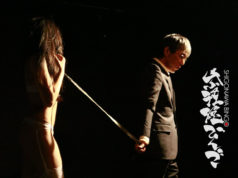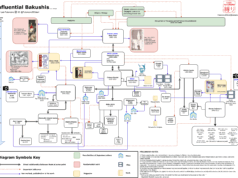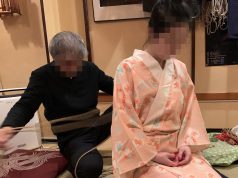雪村流
Ryū. A noun used as a suffix to mean a fashion, a way, a style, manner, or an individual’s school of thought.
Sin: Meeting Haruki Yukimura san for instruction within the context of writing a linked top-bottom article was rather daunting, especially when combined with the fact that I would be tying the SM author Yuki Sakurai san for the first time. I resolved to prepare myself by going in blind, and not studying the sensei’s ties, wanting to know if my own ryū intersected, or came close. I freely use the word Sensei as a mark of respect for a man I discovered to have a deep understanding of human nature and the psychology of desire, eroticism and shame, and not in any sense that Yukimura sensei is my master, nor I his student, for I am submissive to none.
Yuki: It was daunting to meet Yukimura san, because I am a novice rope bottom. I use the word ‘novice’ because I have not yet discovered anything like the full essence of Kinbaku. I tried to leave everything to the other party in order to tell what I felt it is, but in the first place, this is the most difficult thing. Additionally, I could hardly concentrate since it was a lesson and stopped so often. But, throughout the lesson, I came to realize what Yukimura ryū is.
Sin: At his small apartment, Yuki san and I were introduced to Yukimura sensei by Nuit de Tokyo. The tiny living space was set out with a bamboo spar secured in a position to represent the height of a Kamoi door beam, and below on the tatami floor, a simple thin white futon mattress. This was to become the limit of our world for the next three hours.
We sat intently as he began to explain his personal history: the younger student of Minomura Kou (along with Nureki Chimuo and Dan Oniroku), himself the most famous student of Itoh Seiyu, and instrumental in the first version of the legendary SM magazine, Kitan Club. Yukimura sensei then began to detail his ryū, how the sensations of carefully tensioned rope at specific nerve clusters add weight to the scenario of a Bakushi taking a girl, how the atmosphere generated and the critical timing add gravity. Why am I tying this girl in the first place? What is my motive? How she came to be in this predicament was suggested as examples in many ways. The one that captured my imagination within the context of tying Yuki san, was that her husband, out of money, finally placed her virtue as collateral on the card table, and lost. She was now mine to do as I pleased.
Yuki: As Sin san described, there was a simple thin white futon mattress in a tiny tatami room, and everything was to be done there. The lesson started with the Gote. In this regard, a rope bottom should not voluntarily lock her hands behind her back in order to be tied up, because generically it is an out of the ordinary situation to be sitting straight in such a place with a man behind and then to be tied up. The rope bottom will have her own story of why this has happened, and the rope top feels it through the rope. They understand the other’s feelings for each other as a communication via Kinbaku. Since Kinbaku involves risk, we need basic knowledge and technique in order to protect the rope bottoms’ safety. With that in mind, Yukimura san told us that rather than showing rope technique, showing the beauty of a rope bottom is more important. Maybe it wouldn’t be happier for a rope bottom if a rope top brings out unfound beauty in her by tying her up, and to do so, relations between a rope top and a rope bottom are important rather than a self-satisfied technique.
Sin: Yukimura sensei proceeded to expound the imperative of the connection between the two parties through the media of control, tension, touch, grasp, movement, and of course rope, and demonstrated, using Yuki san, to detail the elements of tying his Gote. Everything results in the expressionism in the face and body of the girl, the immaculate beauty of her ignominy. The Gote in itself could not be simpler, but the finite positions of the lines specific to the girl in her condition at that precise moment in time, the capture and subtle force with the arms, chest and elbows to guide her to one’s will while maintaining bodily contact – never looking away from her to the rope – and the cognitive use of Kotobazeme to draw her thoughts in before shaming her deeper, meld together into a moment of intense eroticism. Tension is much more than the taut lines of Yukimura san’s ø4mm jute Aranawa.
I freely admit not being perfect in my first attempt, too much drama of the performer within me. As the second progressed and I had Yuki san’s thoughts walking hand-in-hand into the whispered darkness of my metaphoric tunnel, and as I softly tied off the Gote pulling her with the Nawajiri to lay her head onto my shoulder, I was beginning to wish we were totally alone, because the environment of a lesson with spectators is not altogether conducive, especially as our photographer was also my own special lady. But, it began to crystallize that Yukimura ryū was all about this connection between the two parties, in this case Yuki san and I, and especially the strong erotic element of Shuuchi (a sense of shame, in the rope bottom) to onlookers, the final form of the Gote of far less importance than the moment/s and critical timing of its tying. I cannot stress enough the enduring feeling that, although rope is being used, it is merely the tool between craftsperson and artwork, like a brush, or a chisel.
Yuki: For your information, Yukimura san told me that in the case that a rope top gets a little bored with his rope bottom, the rope bottom senses it much earlier than the rope top realizes it. So he told us that it is always the rope bottom that will lose the feeling of connection first. Such a digression might be special to a private lesson, and it was fun.
Sin: My tying of Yukimura sensei’s Gote to his approval allowed us to progress onto another simple erotic capture, commencing with a single wrap of one wrist at a point that maximizes nerve sensation, and only loose enough for the forepart of a single digit to pass underneath, tied off with a reef knot, wrapped twice around the two wrists at the correct tension – neither too loose, nor too tight – and tied off with another simple reef knot by passing enough loop under the wraps between the wrists and securing to the free lines coming from above. The free end to the Nawajiri now became the subject of intense speculation, the capture of Yuki san complete and ready for the taking.
There followed a long discussion on timing, progression, anticipation and the heightening of Yuki san’s shame, the desire to open her Yukata and touch her breasts. Too fast would be vulgar. Too slow, inept. Raising her arms with the free line from her wrists needed to take into account the required result. Keeping her elbows low enough would allow her to hide her face, and would prohibit the full exposure of her predicament. Likewise, too high would become uncomfortable too quickly, and also limit the movement of her shoulders and head in expressing her emotions. Just like the Tango that cannot be danced alone, there are two players in this scene, and my role is to lead the enhancement of her erotic submission.
With the arms raised to precisely the position I wanted, I could then tease Yuki san, timing my touches to her neck and sternum as Yukimura sensei, sitting behind me joined the Kotobazeme degradation in Japanese, in what was clearly heightening Yuki san’s humiliation. Yukimura ryū now had nothing to do with rope, and everything linked to reading Yuki san’s demeanor; she desires me to advance further, I will take the step, loosen her waistband, tell her that I will see her now, extending the tension, sitting back and watching her delicate movements, intensifying her disgrace, before coming back in and gently sliding the Yukata slowly open like a curtain to expose a single breast, Etc. The genius of the master comedian is in understanding the timing in delivering the punch line. The eroticism of the Bakushi follows a distinctly similar methodology.
This wonderfully delicate balance progressed much further. Breasts fully exposed Yuki san was released to lay down, now in her own thoughts and space, and the simple wrist wrap duplicated above the ankles, so that the legs raised with a line to the Kamoi, and the wrist line secured to the ankle wrap, Yuki san’s legs and buttocks could become the focus of attention as she lay on her back like a wild beast slung beneath a pole.
Yuki: We were told many points. For example, when a rope top wants to change the position of the rope bottom’s arms, he should move her arms along her body. Indeed, this makes the rope bottom’s motion much smoother, so the rope bottom can wallow in the world of Kinbaku much easier. Yukimura san also told us pointers when tying the arms in front of the body. For example, a rope top should not tie both wrists together because he can hardly do it when the rope bottom resists. So he should tie one wrist at first, and then bundle both wrists together. We also tried tying both ankles and then slinging them up, and that was then the end of the lesson. We used only one or two ropes in this lesson. It was an amazing experience to realize how far a single rope could take me. And Kotobazeme (the use of word and dialogue showing an exaggerated wonder at the rope bottom’s arousal) is also used in Yukimura ryū, for stirring up the sense of shame in order to enhance the mood. But Kotobazeme needs a kind of technique not only to use it but also to receive it. To be honest, since it was a part of a stop-start lesson, I could hardly get centered on rope and it was pointed out that my heart was not completely filled. This is one of the points I need to reflect about in the different situations of a lesson, and in intimate private Kinbaku.
Sin: A few more ties were taught before Yukimura sensei clearly appeared to tire. But, before the meet was over we were given more tea and shown images depicting the beauty of the psychological adversity of various models, I began to wonder how anybody but Yukimura sensei himself could possibly hope to teach his ways without being of his singular mind and experience. Like the father of a son, only part of the mix of genetic strands are handed down, the others coming from the mother’s side, or in our case, our own mindsets, cultural backgrounds and upbringings. Those who have been lucky enough to train intensely under Yukimura san are the only ones that could ever hope to scratch this surface, adding their own blends in personal interpretation. This level of eroticism may indeed exist in many who will never have heard of his name, yet unlikely combined with the use of Kinbaku rope play.
Yuki: After the lesson, we talked for a while with a cup of tea. I asked Yukimura san what inspired him to be involved in Kinbaku and SM. He answered simply, “Because it is my sexual inclination”. Then I asked if it means connatural, and he answered that it is sexual propensity rather than inbred. There was no television nor SM related magazines at the time he started tying, so he watched Kinbaku in samurai movie dramas. However, almost all such Kinbaku is Semenawa (torture rope), though Yukimura san places more importance on shaming and caressing by Kinbaku. Thus, Yukimura san is the generation who was involved in Kinbaku far before it appeared in media.
I also asked Yukimura san how he feels about non-Japanese interest in Kinbaku. He said that people with such disposition exist all over the world, so Kinbaku is not a culture that can be only understood by the Japanese. Maybe be it is because Yukimura ryū gives importance not to Kinbaku itself, but on the story that made a couple do Kinbaku. I learned a lot from his attitude that there should be a story, a reason, and I myself would also like to keep expressing stories among rope as a Kinbaku culture beyond national boundaries.
Sin: Yukimura sensei may be one of the last of his generation of Bakushi, and will be sorely missed when he is gone. Those who have been lucky enough to know him will carry their own tales. My wish is to hope to see him again one day.
Yuki Sakurai is a Tokyo-based Kinbaku and BDSM e-book writer. She publishes photo books with herself as the model, and some have been printed in paperback version. Many of her works have been awarded first place in the categories Erotic Fiction, Subculture, Romance, and Erotic Photography in Amazon Kindle Japan. Her website is: http://sakurasm.com
Sin is an expat Londoner resident in Munich with long standing business ties in Japan. After an enforced 10-year vanilla hiatus he took up SM rope-play once more in 2012, becoming a student of Shingonawabingo san. He is a regular performer, but shys away from photography or video.













